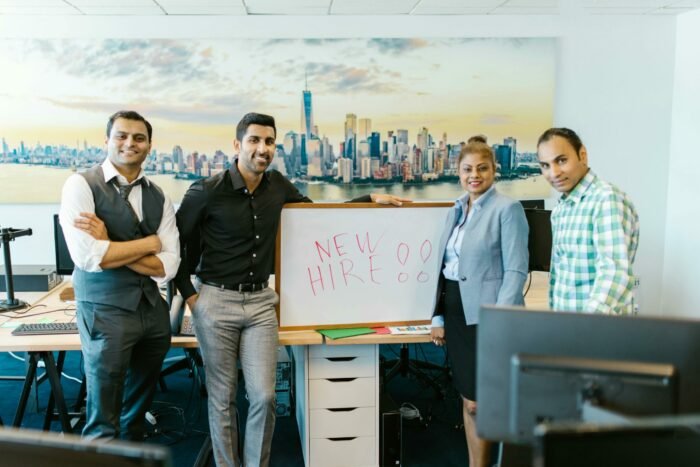In today’s dynamic and technology-driven job market, traditional recruitment methods are rapidly evolving to keep pace with changing demands and advancements. Among these transformative shifts is the rise of asynchronous video interviewing, a practice that has revolutionized how organizations engage with prospective candidates. Asynchronous video interviewing represents a departure from the conventional in-person or synchronous virtual interviews, offering a flexible and efficient alternative that caters to the needs of both candidates and hiring teams.
This article delves into the art of asynchronous video interviewing, exploring its nuances, benefits, challenges, and best practices. From defining the concept to examining its evolution in the context of modern hiring practices, we aim to provide a comprehensive understanding of this innovative recruitment approach. By delving into the intricacies of asynchronous video interviewing, organizations can unlock new avenues for talent acquisition, streamline their hiring processes, and enhance the overall candidate experience.
Join us on a journey to explore the artistry behind asynchronous video interviewing, and discover how this transformative practice is reshaping the landscape of recruitment in the digital age.
Key Takeaways
- Asynchronous video interviews offer flexibility for candidates and hiring teams, allowing interviews to be conducted at convenient times.
- Clear Communication and thorough instructions are essential to ensure a smooth interview process for candidates.
- Leveraging technology effectively can streamline the asynchronous video interview process and enhance the candidate experience.
- Organizations should carefully select platforms based on factors such as cost, ease of use, and compatibility with existing systems.
- Providing feedback and support throughout the process contributes to a positive candidate experience and fosters engagement.
- Tracking metrics and adapting to emerging trends are critical for evaluating the effectiveness of asynchronous video interviews and staying competitive in the job market.
Understanding Asynchronous Video Interviewing
Asynchronous video interviewing is a modern recruitment method that diverges from traditional synchronous interviews, providing both candidates and hiring teams with a flexible and convenient alternative. This section delves into the intricacies of asynchronous video interviewing, exploring its key components, processes, and distinctive features that differentiate it from conventional interview formats. By gaining a deeper understanding of asynchronous video interviewing, organizations can harness its potential to revolutionize their recruitment practices and enhance the candidate experience.
Evolution of Hiring Methods towards Asynchronous Video Interviews
The evolution of hiring methods towards asynchronous video interviews signifies a shift from traditional in-person and synchronous virtual interviews to a more flexible and efficient approach. Traditional methods, including in-person and phone interviews, gave way to synchronous video interviews, which, while offering remote accessibility, presented challenges such as scheduling conflicts. Asynchronous video interviews emerged as a solution to address these challenges, providing candidates with the flexibility to record responses at their convenience. This transition has been driven by the integration of asynchronous video interviewing platforms into modern recruitment practices, reflecting its acceptance among employers and candidates alike. Continuous innovation and adaptation, driven by technological advancements and changing market dynamics, ensure the relevance and effectiveness of asynchronous video interviews in the evolving recruitment landscape. Overall, asynchronous video interviews represent a significant evolution in hiring methods, offering organizations a modern, flexible, and efficient approach to talent acquisition.
Benefits of Asynchronous Video Interviews
Asynchronous video interviews offer numerous advantages for both candidates and hiring teams:
- Increased Reach: Candidates from diverse locations can participate, overcoming geographical barriers.
- Flexibility: Candidates and hiring teams can conduct interviews at their convenience, improving scheduling flexibility.
- Time Efficiency: Streamlined screening processes lead to faster hiring decisions and reduced time-to-fill vacancies.
- Enhanced Candidate Experience: Candidates appreciate the convenience and accessibility of remote interviews, leading to higher satisfaction levels.
- Improved Assessment: Hiring teams can thoroughly evaluate candidate responses, leading to better-informed hiring decisions.
- Cost Savings: Reduced travel expenses and streamlined processes result in cost savings for both candidates and organizations.
- Scalability: Asynchronous video interviews can accommodate large volumes of candidates efficiently.
- Environmental Sustainability: Minimized travel contributes to environmental sustainability by reducing carbon emissions.
- Data-Driven Insights: Platforms offer analytics to track recruitment metrics and optimize processes.
- Compliance and Documentation: Digital records ensure transparency and compliance with regulations.
Best Practices for Conducting Asynchronous Video Interviews
| Best Practices | Description |
|---|---|
| Transparency and Clear Expectations | Communicate the interview process and set expectations regarding format, timeline, and evaluation criteria. |
| Thorough Instructions and Guidance | Provide detailed instructions on accessing the platform, recording responses, and submitting interviews. Offer technical guidance and support. |
| Personalized Touch | Record personalized video introductions and questions to create an engaging atmosphere. Highlight organizational culture and values. |
| Structured Questioning | Design clear, relevant questions to assess specific skills and competencies. Ensure consistency in format and difficulty. |
| Candidate Support | Offer technical assistance and a point of contact for questions or concerns. Provide timely feedback on completed interviews. |
| Timely Feedback | Establish a timeline for providing constructive feedback to candidates. Highlight strengths and areas for improvement. |
| Respect Candidate Privacy | Ensure compliance with privacy regulations. Communicate how candidate data will be used and stored. |
| Training for Hiring Teams | Provide training to hiring managers on effectively reviewing and evaluating asynchronous video interviews. Emphasize objectivity and fairness. |
| Accessibility Considerations | Ensure platform accessibility for candidates with disabilities. Provide alternative formats and accommodations as needed. |
| Continuous Improvement | Solicit feedback from candidates and hiring teams to identify areas for improvement. Regularly review and refine best practices based on feedback and evolving trends. |
Challenges and Solutions in Asynchronous Video Interviews
Challenges:
- Platform Costs and Requirements: Dedicated platforms may incur additional costs, and organizations need to ensure they meet their specific requirements.
- Learning Curve for Candidates and Staff: Both candidates and recruiting staff may face challenges in adapting to the new asynchronous video interview format.
- Promoting a Positive Candidate Experience: Maintaining a personalized and engaging experience for candidates can be challenging in a remote interview setting.
Solutions:
- Platform Costs and Requirements: Choose cost-effective platforms and negotiate pricing to reduce expenses.
- Learning Curve for Candidates and Staff: Provide comprehensive training, tutorials, and support to help individuals become familiar with the platform.
- Promoting a Positive Candidate Experience: Record personalized introductions, offer clear guidance and support, and encourage engaging content from hiring managers to enhance the candidate experience.
These solutions aim to address the challenges and ensure a smooth and positive asynchronous video interviewing process for all parties involved.
Implementing Asynchronous Video Interviews Effectively
Implementing asynchronous video interviews effectively involves:
- Clear Communication: Clearly communicate expectations and guidelines to candidates and hiring teams.
- Training and Support: Provide comprehensive training and technical support to ensure familiarity with the platform.
- Structured Questions: Design relevant and consistent interview questions aligned with hiring criteria.
- Technology Integration: Seamlessly integrate the platform with existing workflows and ensure compatibility with other tools.
- Enhanced Candidate Experience: Focus on providing clear instructions, timely feedback, and support throughout the process.
- Feedback Mechanism: Establish a feedback loop to gather insights and refine the process continuously.
- Evaluation and Improvement: Regularly evaluate performance metrics and adapt the process to meet changing needs.
By addressing these key areas, organizations can optimize their asynchronous video interview process, improving efficiency and candidate experience.
Integration into Recruitment Process and Benefits
Integrating asynchronous video interviews into the recruitment process offers various benefits:
- Enhanced Candidate Experience: Provides flexibility for candidates to complete interviews remotely and at their convenience, with clear instructions and support throughout.
- Improved Evaluation of Skills and Qualifications: Allows for thorough assessment of candidates’ abilities through multiple reviews of their responses, leading to informed decision-making.
- Streamlined Recruitment Process: Reduces scheduling conflicts and accelerates hiring timelines by eliminating the need for real-time coordination, resulting in cost and time savings.
- Cost Efficiency: Saves expenses associated with candidate travel for in-person interviews, making the process more accessible and scalable for high-volume recruitment.
- Flexibility for Hiring Teams: Allows hiring managers to review candidate responses at their convenience, balancing recruitment responsibilities effectively.
- Quality of Hires: Enables the selection of top-quality candidates through comprehensive evaluations, leading to improved retention rates and organizational success.
Overall, incorporating asynchronous video interviews enhances the recruitment process, attracting and selecting top talent efficiently while providing a positive experience for candidates and hiring teams alike.
Technology Requirements and Platform Selection
Selecting the right technology platform for asynchronous video interviewing involves several key considerations:
- Platform Features: Evaluate platforms based on factors like cost, ease of use, security, and compatibility with existing systems.
- Integration: Ensure seamless integration with existing workflows and ATS to streamline recruitment processes.
- Security and Compliance: Prioritize platforms that adhere to industry standards for data security and compliance.
- Candidate Experience: Choose platforms with user-friendly interfaces and accessibility features to enhance the candidate experience.
- Scalability and Customization: Select platforms that can accommodate varying recruitment needs and grow with organizational requirements.
- Accessibility: Ensure platforms are accessible to candidates with disabilities, promoting inclusivity in the recruitment process.
- Trial Periods: Take advantage of demo or trial periods to test platform functionality and gather feedback from stakeholders.
- Vendor Support: Assess the level of support and training provided by platform vendors to ensure successful adoption.
By considering these factors and selecting the appropriate platform, organizations can effectively leverage technology to optimize their asynchronous video interviewing process and improve recruitment outcomes.
Candidate Experience and Engagement
Ensuring a positive candidate experience and fostering engagement during asynchronous video interviews involves several key strategies:
- User-Friendly Interface: Provide candidates with an intuitive platform for easy navigation.
- Clear Communication: Communicate transparently about the interview process and expectations.
- Feedback and Support: Offer timely feedback and dedicated support channels for candidates.
- Personalization and Engagement: Incorporate personalized elements and interactive features to enhance engagement.
- Accessibility and Inclusivity: Ensure the platform is accessible to candidates with disabilities and accommodates diverse needs.
- Continuous Communication: Maintain ongoing communication and responsiveness throughout the process.
- Brand Representation: Showcase the organization’s brand and culture to create a positive impression on candidates.
By implementing these strategies, organizations can prioritize candidate experience and engagement, ultimately strengthening their recruitment efforts and employer brand.
Measuring the Impact of Asynchronous Video Interviews
Measuring the impact of asynchronous video interviews involves tracking key metrics such as response rates, completion rates, and time-to-hire. Candidate feedback and satisfaction, along with hiring team efficiency, provide valuable insights. Evaluating the quality of hires and conducting comparative analysis between asynchronous and traditional interview methods helps assess effectiveness. Utilizing technology and platform analytics aids in optimizing the process, while continuous improvement based on data and feedback ensures ongoing enhancement of asynchronous video interviews.
Future Trends and Innovations
Future trends and innovations in asynchronous video interviews include the integration of virtual reality (VR) and augmented reality (AR) for an immersive experience, leveraging artificial intelligence (AI) for automated candidate assessment, utilizing advanced analytics and predictive modeling for data-driven insights, developing customizable interview templates, adapting platforms to be mobile-friendly, implementing blockchain technology for enhanced data security, utilizing natural language processing (NLP) for candidate feedback, and integrating gamification elements for increased engagement. These advancements aim to improve candidate experience, efficiency, and effectiveness in the recruitment process.
Conclusion
In conclusion, asynchronous video interviews represent a modern and innovative approach to recruitment, leveraging technology to streamline the hiring process while enhancing the candidate experience. Through increased reach, flexibility in scheduling, and efficiency gains, organizations can benefit from a more streamlined and effective recruitment process.
However, implementing asynchronous video interviews requires careful consideration of best practices, including transparent communication, thorough instructions, and leveraging technology effectively. Addressing challenges such as platform selection and candidate engagement is essential for maximizing the benefits of asynchronous video interviews.
As organizations continue to integrate asynchronous video interviews into their recruitment processes, tracking metrics and adapting to emerging trends will be crucial for evaluating effectiveness and staying ahead in a dynamic job market. By embracing these practices and staying attuned to evolving technologies and candidate preferences, organizations can successfully navigate the changing landscape of recruitment, ultimately leading to better hiring decisions and a more positive experience for candidates and hiring teams alike.












